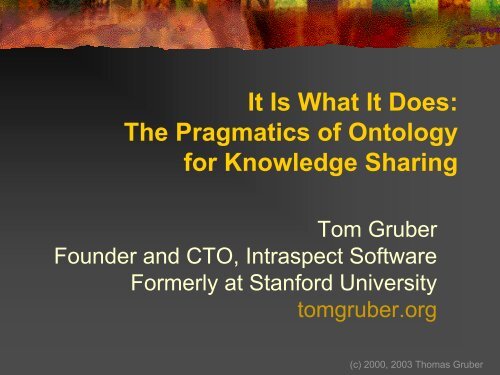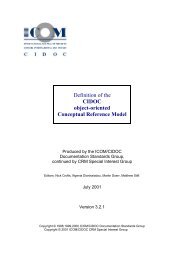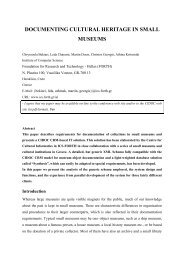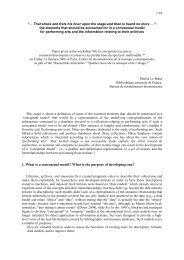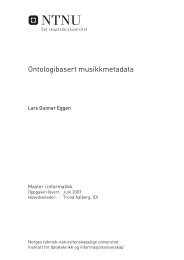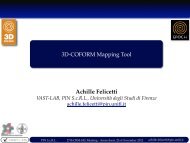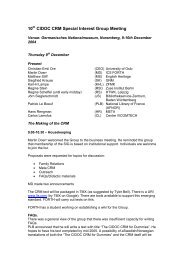It Is What It Does: The Pragmatics of Ontology as ... - Tom Gruber
It Is What It Does: The Pragmatics of Ontology as ... - Tom Gruber
It Is What It Does: The Pragmatics of Ontology as ... - Tom Gruber
You also want an ePaper? Increase the reach of your titles
YUMPU automatically turns print PDFs into web optimized ePapers that Google loves.
<strong>It</strong> <strong>Is</strong> <strong>What</strong> <strong>It</strong> <strong>Does</strong>:<strong>The</strong> <strong>Pragmatics</strong> <strong>of</strong> <strong>Ontology</strong>for Knowledge Sharing<strong>Tom</strong> <strong>Gruber</strong>Founder and CTO, Intr<strong>as</strong>pect S<strong>of</strong>twareFormerly at Stanford Universitytomgruber.org(c) 2000, 2003 Thom<strong>as</strong> <strong>Gruber</strong>
<strong>What</strong> is this talk about?• <strong>What</strong> are ontologies?• <strong>The</strong>oretical perspective• <strong>What</strong> are they for?• Pragmatic perspective• How do we build them?• Design perspective(c) 2000, 2003 Thom<strong>as</strong> <strong>Gruber</strong>
<strong>What</strong> is an ontology?• An ontology is an explicit specification <strong>of</strong> aconceptualization.• A conceptualization is an abstract,simplified view <strong>of</strong> the world that we want torepresent.• If the specification medium is a formallanguage, the ontology defines arepresentational foundation.(c) 2000, 2003 Thom<strong>as</strong> <strong>Gruber</strong>
<strong>Ontology</strong>, Knowledge, andCommitment• <strong>The</strong> Knowledge-level:a level <strong>of</strong> description <strong>of</strong> the knowledge <strong>of</strong> anagent that is independent <strong>of</strong> internal format.• An agent “knows” if it acts like it does.• A s<strong>of</strong>tware agent “acts” by telling and <strong>as</strong>king.• An agent commits (conforms) to an ontology if it“acts” consistently with the definitions• Ontological Commitments are agreements to use thevocabulary in a coherent and consistent manner.• Common ontology ≠ common knowledge.(c) 2000, 2003 Thom<strong>as</strong> <strong>Gruber</strong>
<strong>What</strong> isn’t an ontology?• a datab<strong>as</strong>e or program• because they share internal formats• a conceptualization• because it isn’t a specification - it’s a vision• a table <strong>of</strong> contents• but wait, isn’t a Taxonomy an <strong>Ontology</strong>?• only if it defines a set <strong>of</strong> concepts(c) 2000, 2003 Thom<strong>as</strong> <strong>Gruber</strong>
<strong>Ontology</strong> and LanguageLanguage = syntax + vocabulary• One can use the ontology <strong>as</strong> arepresentation language• Penman ontology for natural languageprocessing• *ML industry agreements(c) 2000, 2003 Thom<strong>as</strong> <strong>Gruber</strong>
<strong>The</strong> role <strong>of</strong> formalism• Formal specification helps communicatethe definition <strong>of</strong> terms in reader- andcontext-independent ways.• Formal language semantics allows someautomated consistency checks.• Formal axiomatization is never sufficient.• <strong>It</strong> always comes down to the primitives!(c) 2000, 2003 Thom<strong>as</strong> <strong>Gruber</strong>
Example Ontologies: Very FormalFormal => (partially) Computable Semantics• EngMath - b<strong>as</strong>is for mathematical modeling <strong>of</strong>physical systems• physical quantities, units, dimensions• Frame <strong>Ontology</strong> - unifying theory for frameb<strong>as</strong>edrepresentation systems• cl<strong>as</strong>ses, relations, slots• Configuration Design - for representing adesign t<strong>as</strong>k• components, subparts, attributes, constraints(c) 2000, 2003 Thom<strong>as</strong> <strong>Gruber</strong>
Example Ontologies: SemiformalSemiformal => useful computations on formal part• Reference Dictionaries and <strong>The</strong>sauri - domainterms and untyped relations among them• <strong>Ontology</strong>.org - XML b<strong>as</strong>ed industry standardsfor e-commerce data exchange• product, price, …• CIDOC CRM - conceptual reference model forcultural heritage data• place, time span, appellation, right(c) 2000, 2003 Thom<strong>as</strong> <strong>Gruber</strong>
Example Ontologies: InformalInformal => human interpretation aided bycomputation• (Non-semantic) Web <strong>Ontology</strong> - for identifyingand linking information objects• Thing-with-URI, Link• Intr<strong>as</strong>pect’s Context <strong>Ontology</strong> - for capturingand sharing information in its context <strong>of</strong> use byknowledge workers• parent/child, document, message, comment(c) 2000, 2003 Thom<strong>as</strong> <strong>Gruber</strong>
<strong>The</strong> Intr<strong>as</strong>pect <strong>Ontology</strong>• Hierarchy with typed nodes• allow multiple parents, no inheritance• Implicit metadata (contributor, date, file type)• Explicit metadata• titles and descriptions• user-defined types and attributes (“deliverable”)• Conversational relations• next-in-thread/in-reply-to (inferred from email)• context-sensitive annotation(c) 2000, 2003 Thom<strong>as</strong> <strong>Gruber</strong>
Representing the Context <strong>of</strong> UseMarketingEngineeringCompetitive IntelligenceResearchDiscussion about competitionProject XMessage about competitorTechnology evaluationCompetitor Web PageMarketing commentEngineering commentWhy? Knowledge is created in context;information in context can be reused.(c) 2000, 2003 Thom<strong>as</strong> <strong>Gruber</strong>
A Pragmatic Perspective• Ontologies are not about truth or beauty.• <strong>The</strong>y are agreements, made in a socialcontext, to accomplish some objectives.• <strong>It</strong>’s important to understand thoseobjectives, and be guided by them.(c) 2000, 2003 Thom<strong>as</strong> <strong>Gruber</strong>
Why Create Ontologies?• to enable data exchange among programs• to simplify unification (or translation) <strong>of</strong>disparate representations• to employ knowledge-b<strong>as</strong>ed services• to embody the representation <strong>of</strong> a theory• <strong>as</strong> a reference to guide new formalizations• to facilitate communication among people(c) 2000, 2003 Thom<strong>as</strong> <strong>Gruber</strong>
<strong>Ontology</strong> <strong>as</strong> ContractPurposes <strong>of</strong> Ontologies• data exchange• Unification andtranslation• calling knowledgeservices• representing theories• humancommunicationParties to the Contract• programmers• library scientists,datab<strong>as</strong>e mediators• programmers,netbots• scientists,AI programs• collaborators(c) 2000, 2003 Thom<strong>as</strong> <strong>Gruber</strong>
Ontologies <strong>as</strong> Designed Artifacts(c) 2000, 2003 Thom<strong>as</strong> <strong>Gruber</strong>
<strong>The</strong> Design Perspective• Ontologies are designed to meetfunctional objectives.• data exchange, unification, representation,communication …• Representational choices are designdecisions.• Design methodologies include validation,optimization against design criteria.(c) 2000, 2003 Thom<strong>as</strong> <strong>Gruber</strong>
General Design Criteria forOntological Engineering• Clarity - context-independent, unambiguous,precise definitions• Coherence - internally consistent• Extendibility - anticipate the uses <strong>of</strong> thevocabulary, allow monotonic extension• Minimal Encoding Bi<strong>as</strong> - avoidrepresentational choice for benefit <strong>of</strong>implementation• Minimal Ontological Commitment - defineonly necessary terms, omit domain theory(c) 2000, 2003 Thom<strong>as</strong> <strong>Gruber</strong>
Wrap up• Ontologies are what they do: artifacts tohelp people and their programscommunicate, coordinate, collaborate.• We should design and build them ….• for humans!(c) 2000, 2003 Thom<strong>as</strong> <strong>Gruber</strong>


